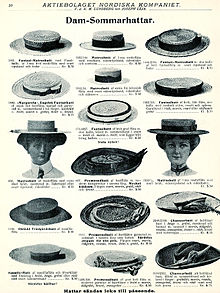


A straw hat is a wide-brimmed hat woven out of straw or straw-like synthetic materials.[1] Straw hats are a type of sun hat designed to shade the head and face from direct sunlight, but are also used in fashion as a decorative element or a uniform.



A straw hat is a wide-brimmed hat woven out of straw or straw-like synthetic materials.[1] Straw hats are a type of sun hat designed to shade the head and face from direct sunlight, but are also used in fashion as a decorative element or a uniform.
Commonly used fibers are:[2]
There are several styles of straw hats, but all of them are woven using some form of plant fibre.[15][16] Many of these hats are formed in a similar way to felt hats; they are softened by steam or by submersion in hot water, and then formed by hand or over a hat block. Finer and more expensive straw hats have a tighter and more consistent weave. Since it takes much more time to weave a larger hat than a smaller one, larger hats are more expensive.[citation needed]
Straw hats have been worn in Africa and Asia since after the Middle Ages during the summer months, and have changed little between the medieval times and today. They are worn, mostly by men, by all classes. Many can be seen in the calendar miniatures of the Très Riches Heures du Duc de Berry.

The mokorotlo, a local design of a straw hat, is the national symbol of the Basotho and Lesotho peoples, and of the nation of Lesotho. It is displayed on Lesotho license plates.
Betsey Metcalf Baker (née Betsey Metcalf; 1786–1867)[17] was a manufacturer of straw bonnets, entrepreneur, and social activist based in Providence, Rhode Island and Westwood, Massachusetts. At age twelve, she developed a technique for braiding straw, allowing her to emulate the styles of expensive straw bonnets and make them accessible to working-class women. Rather than patent her technique, Baker taught the women in her community how to make straw bonnets, enabling the development of a cottage industry in New England.[18]
Because of the Napoleonic Wars, the United States embargoed all trade with France and Great Britain for a time, creating a need for American-made hats to replace European millinery. The straw-weaving industry filled the gap, with over $500,000 ($9 million in today's money) worth of straw bonnets produced in Massachusetts alone in 1810.[19]
On May 5, 1809, Mary Dixon Kies received a patent for a new technique of weaving straw with silk and thread to make hats.[20][21] Some sources say she was the first woman to receive a US Patent,[22][23] however other sources cite Hannah Slater in 1793,[24][25][26] or Hazel Irwin, who received a patent for a cheese press in 1808,[27][24] as the first.
President Theodore Roosevelt posed for a series of photos at the Panama Canal construction site in 1906. He was portrayed as a strong, rugged leader dressed crisply in light-colored suits and stylish straw fedoras. This helped popularize the straw "Panama hat".[28]
The Old Order Amish, in the United States, still wear straw hats (similar to a Boater Hat), especially in the summer months. In the winter, or for formal wear, they will wear a felt hat.
Artwork produced during the Middle Ages shows, among the more fashionably dressed, possibly the most spectacular straw hats ever seen on men in the West, notably those worn in the Arnolfini Portrait of 1434 by Jan van Eyck (tall, stained black) and by Saint George in a painting by Pisanello of around the same date (left). In the middle of the 18th century, it was fashionable for rich ladies to dress as country girls with a low crowned and wide brimmed straw hat to complete the look.[29]